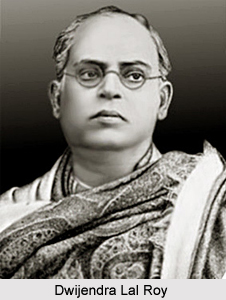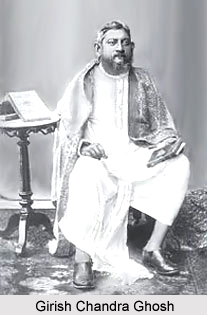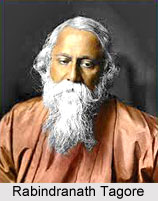 Bengali drama in early twentieth century saw a flourishing of a professional theatre industry in Kolkata. A number of dramatists and playwrights emerged during this period who contributed significantly to the field of Bengali drama. Prominent among the dramatists of this period was Girish Chandra Ghosh (1844-1911), the leading name who towered over the contemporary theatrical scene. He was not only one of the pioneering producers for the professional Bengali theatre but also one of its greatest directors, an actor, an innovative designer, a lyricist-composer, and undoubtedly its first great playwright. His plays were filled with a sense of deep social commitment that expressed itself both directly as well as metaphorically. In a career that spanned over four decades, Girish wrote more than 40 plays which included historical, mythological and social genres, and innumerable essays on theatre and social issues. Besides, his numerous contributions to Bengali theatre, Girish gave Bengali poetic drama the gift of a resonant meter, commonly known as the "Gairis" (the adjective form of Girish in Bengali) prosodic measure. He started his career with adaptations of already famous narrative and epic poems of the nineteenth century but soon achieved enough mastery over the dramatic form to write original plays.
Bengali drama in early twentieth century saw a flourishing of a professional theatre industry in Kolkata. A number of dramatists and playwrights emerged during this period who contributed significantly to the field of Bengali drama. Prominent among the dramatists of this period was Girish Chandra Ghosh (1844-1911), the leading name who towered over the contemporary theatrical scene. He was not only one of the pioneering producers for the professional Bengali theatre but also one of its greatest directors, an actor, an innovative designer, a lyricist-composer, and undoubtedly its first great playwright. His plays were filled with a sense of deep social commitment that expressed itself both directly as well as metaphorically. In a career that spanned over four decades, Girish wrote more than 40 plays which included historical, mythological and social genres, and innumerable essays on theatre and social issues. Besides, his numerous contributions to Bengali theatre, Girish gave Bengali poetic drama the gift of a resonant meter, commonly known as the "Gairis" (the adjective form of Girish in Bengali) prosodic measure. He started his career with adaptations of already famous narrative and epic poems of the nineteenth century but soon achieved enough mastery over the dramatic form to write original plays.
Writing profusely during the last quarter of the nineteenth century and the first decade of the twentieth, Girish Ghosh gave Bengali literature its first volume of masterful drama that reflected the Bengali taste for theatre. The last decade of his life, also the first decade of the twentieth century, was probably one of the most prolific periods of Girish`s career. During this period, he wrote two of his most accurate historical plays, in terms of the technicalities of drama-writing, on the early days of British rule in Bengal. The serial plays Siraj-Ud-Daulah (1905) and Mir-Qasim (1906). In 1905, he also wrote the second of his 2 most celebrated social plays, Balidan (The Sacrifice). In 1907, he wrote Chatrapati Shivaji, a biographical play on the Maratha king who intimidated the mighty Mughals. Again his play on Mahaprabhu Chaitnya is undoubtedly a path breaking one.
 Among the other major playwrights writing at the turn of the century was Girish`s friend and colleague Amritalal Basu (1853-1929), also an actor-producer, whose forte was comedy and social satire. Among his notable achievements after 1900 are a Bengali adaptation of Moliere`s `The Miser` in 1900, as `Kripaner Dhan` (The Miser`s Wealth), Adarsa Bandhu (The Ideal Friend, 1900), and Nabafauban (Early Youth, 1914). Another contemporary of Girish was Dwijendra Lal Roy (1863-1913), who gave to Bengali theatre a bouquet of the best patriotic plays. Ray was also a great composer and lyricist, whose songs continue to be sung and released on albums. Two of his best plays are Sajdhan (1910), on the last days of the second to last Mughal emperor, who died in captivity and Chandragupta (1911), set in ancient India. The other notable playwright at this time was Ksirodprasad Bidyabinod (1863-1927), who will be remembered for his highly popular Bengali version of Ali Baba (1897), from the one thousand and one Arabian Nights, and his historical and mythological plays, which include Banger Pratdpaditya (1903) and Narandrayan (1926).
Among the other major playwrights writing at the turn of the century was Girish`s friend and colleague Amritalal Basu (1853-1929), also an actor-producer, whose forte was comedy and social satire. Among his notable achievements after 1900 are a Bengali adaptation of Moliere`s `The Miser` in 1900, as `Kripaner Dhan` (The Miser`s Wealth), Adarsa Bandhu (The Ideal Friend, 1900), and Nabafauban (Early Youth, 1914). Another contemporary of Girish was Dwijendra Lal Roy (1863-1913), who gave to Bengali theatre a bouquet of the best patriotic plays. Ray was also a great composer and lyricist, whose songs continue to be sung and released on albums. Two of his best plays are Sajdhan (1910), on the last days of the second to last Mughal emperor, who died in captivity and Chandragupta (1911), set in ancient India. The other notable playwright at this time was Ksirodprasad Bidyabinod (1863-1927), who will be remembered for his highly popular Bengali version of Ali Baba (1897), from the one thousand and one Arabian Nights, and his historical and mythological plays, which include Banger Pratdpaditya (1903) and Narandrayan (1926).
Star Theatre (1883-87) had its establishment completed by the actors Girish Chandra Ghosh, Binodini, Amritalal Basu and others at 68, Beadon Street, Calcutta. Gurmukh Roy, a young non-Bengali, agreed to finance the theatre provided that Binodini agreed to become his mistress and the later agreed to this. Initially the theatre was to be named B-Theatre after Binodini. However, it was ultimately named Star Theatre. The Star opened on 21 July 1883 with Daksayajna, written by Girish Chandra Ghosh. Later Gurmukh sold the theatre to Amritalal Basu, Amritalal Mitra, Dasu Neogi and Hari Bose. From 1883 to 1887 a total of 20 plays were produced at the Star. Apart from Girish Chandra Ghosh, Amritalal Bose, and Binodini, the casts of these plays included Amritalal Mitra, Amrita Mukherjee, Kadambini, Gangamoni, and Kshetramoni. Sri Ramkrishna saw Binodini acting in Chaitanyalila and was so moved by her acting that he blessed her. When the land of Star Theatre at 68 Beadon Street was sold, the dramatic group purchased a land at 76/3, Cornwalish Street, Hatibagan, and built a new Star Theatre House which was also called Hatibagan Star Theatre. In addition, he wrote a play for the opening of the new Star Theatre. It opened on 25 May 1888 with the drama Nasiram by `Sevak`, i.e. Girish Chandra in disguise. Hatibagan Star was famous for over 100 years.
 During its existence, its ownership changed many times, and the building was renovated and modernised from time to time. Nearly 250 Bangla dramas of more than 80 playwrights including Girish Chandra Ghosh, Rabindranath Tagore, Amritalal Basu, Dwijendralal Roy, Kshirod Prasad Vidyavinod, Mahendra Gupta, Debnarayan Gupta and many others were performed by different producers. More than 12 Hindi dramas were also staged at the Theatre. The casts included innumerable artists of the time. Among them were Girish Chandra Ghosh, Amritalal Basu, Gangamoni, Kadambini, Amor Dutta, Dani Babu, Tarasundari, Kusum Kumari, Aparesh Chandra, Shishir Kumar, Ahindra Chowdhury, Niharbala, Sarajubala, Chhabi Biswas, Uttam Kumar, Sabitri Chatterjee, Soumitra Chatterjee, Bhanu Banerjee, Rabi Ghose, Premangshu Bose, Anup Kumar and others. Unfortunately a fire destroyed the glorious Star Theatre on 16 October 1991. Nevertheless, the burnt skeleton and facade of the Star is still standing at the same place revealing its original architectural finesse and beauty.
During its existence, its ownership changed many times, and the building was renovated and modernised from time to time. Nearly 250 Bangla dramas of more than 80 playwrights including Girish Chandra Ghosh, Rabindranath Tagore, Amritalal Basu, Dwijendralal Roy, Kshirod Prasad Vidyavinod, Mahendra Gupta, Debnarayan Gupta and many others were performed by different producers. More than 12 Hindi dramas were also staged at the Theatre. The casts included innumerable artists of the time. Among them were Girish Chandra Ghosh, Amritalal Basu, Gangamoni, Kadambini, Amor Dutta, Dani Babu, Tarasundari, Kusum Kumari, Aparesh Chandra, Shishir Kumar, Ahindra Chowdhury, Niharbala, Sarajubala, Chhabi Biswas, Uttam Kumar, Sabitri Chatterjee, Soumitra Chatterjee, Bhanu Banerjee, Rabi Ghose, Premangshu Bose, Anup Kumar and others. Unfortunately a fire destroyed the glorious Star Theatre on 16 October 1991. Nevertheless, the burnt skeleton and facade of the Star is still standing at the same place revealing its original architectural finesse and beauty.
Bengali drama in the twentieth thus saw a terrific growth in terms of plays as well as the technicalities of drama. There were a number of dramatic works written during the time by many accomplished dramatists who focused on the social issues of the time apart from writing many historical as well as mythological plays.



















